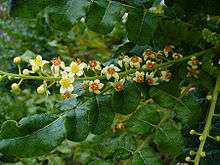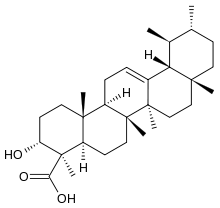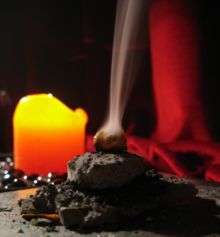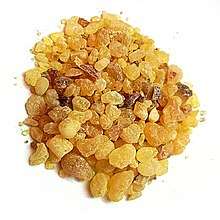Frankincense
Frankincense (also known as olibanum, Persian: کندر [Kondoor], Hebrew: לבונה [levoˈna], Arabic: اللبان al-libān or Arabic: البخور al-bakhūr, Somali: uunsii Somali pronunciation: [unsi]) is an aromatic resin used in incense and perfumes, obtained from trees of the genus Boswellia in the family Burseraceae, particularly Boswellia sacra (syn. B. bhaw-dajiana), B. carterii, B. frereana, B. serrata (B. thurifera, Indian frankincense), and B. papyrifera. The word is from Old French franc encens ('high-quality incense').[1]


There are five main species of Boswellia that produce true frankincense.[2] Resin from each of the five is available in various grades, which depend on the time of harvesting. The resin is hand-sorted for quality.
Etymology
The English word frankincense derives from the Old French expression franc encens, meaning "high-quality incense". The word franc in Old French meant "noble" or "pure".[3]
A popular folk etymology suggests a connection with the Franks (and often in particular Frankish Crusaders), who reintroduced the spice to Western Europe during the Middle Ages, but the word itself comes from the expression.[3][4]
In Greek (the language of the New Testament), Arabic, Phoenician and Hebrew, the name of Frankincense is cognate with the name of Lebanon; this is postulated to be because they both derive from the word for "white" and that the spice route went via Mount Lebanon.[5]
Description

Frankincense is tapped from the scraggly but hardy trees by striping (slashing the bark) and letting the exuded resin bleed out and harden. The hardened streaks of resin are called tears. Several species and varieties of frankincense trees each produce a slightly different type of resin. Differences in soil and climate create even more diversity of the resin, even within the same species.
Boswellia sacra trees are considered unusual for their ability to grow in environments so unforgiving that they sometimes grow out of solid rock. The initial means of attachment to the rock is unknown, but is accomplished by a bulbous disk-like swelling of the trunk. This growth prevents violent storms from detaching the tree. This feature is slight or absent in trees that grow in rocky soil or gravel.
The trees start producing resin at about eight to 10 years old.[6] Tapping is done two to three times a year with the final taps producing the best tears due to their higher aromatic terpene, sesquiterpene and diterpene content. Generally speaking, the more opaque resins are the best quality. Fine resin is produced in Somalia, from which the Roman Catholic Church purchases most of its stock.[7]
Recent studies indicate that frankincense tree populations are declining, partly due to over-exploitation.[8][9] Heavily tapped trees produce seeds that germinate at only 16% while seeds of trees that had not been tapped germinate at more than 80%. In addition, burning, grazing, and attacks by the longhorn beetle have reduced the tree population.[10] Conversion (clearing) of frankincense woodlands to agriculture is also a major threat.[11]
Chemical composition

These are some of the chemical compounds present in frankincense:
- acid resin (6%), soluble in alcohol and having the formula C20H32O4[12]
- gum (similar to gum arabic) 30–36%[12]
- 3-acetyl-beta-boswellic acid (Boswellia sacra)[13]
- alpha-boswellic acid (Boswellia sacra)[13]
- incensole acetate, C21H34O3[14]
- phellandrene[12]
See the following references for a comprehensive overview of the chemical compounds in different frankincense species.[15][16]
History


Frankincense has been traded on the Arabian Peninsula for more than 6,000 years.[17] [18] Its use was characteristic in religious rites throughout Mesopotamia and the Eastern Mediterranean from the earliest antiquity.
Frankincense was reintroduced to Europe by Frankish Crusaders, although its name refers to its quality, not to the Franks themselves.[1] Though it is better known as "frankincense" to westerners, the resin is also known as olibanum, or in Arabic al-lubān (لبان, roughly translated: "that which results from milking"), a reference to the milky sap tapped from the Boswellia tree.
The Greek historian Herodotus was familiar with frankincense and knew it was harvested from trees in Southern Arabia. He reported that the gum was dangerous to harvest because of venomous snakes that lived in the trees. He goes on to describe the method used by the Arabs to get around this problem, that being the burning of the gum of the styrax tree whose smoke would drive the snakes away.[19] Theophrastus mentions the resin, as does Pliny the Elder in his Naturalis Historia.
Southern Arabia was a major exporter of frankincense in antiquity, with some of it being traded as far as China. The 13th-century Chinese writer and customs inspector Zhao Rugua wrote on the origin of frankincense, and of its being traded to China:
"Ruxiang or xunluxiang comes from the three Dashi [Arab] countries of Murbat (Maloba), Shihr (Shihe), and Dhofar (Nufa), from the depths of the remotest mountains.[20] The tree which yields this drug may generally be compared to the pine tree. Its trunk is notched with a hatchet, upon which the resin flows out, and, when hardened, turns into incense, which is gathered and made into lumps. It is transported on elephants to the Dashi (on the coast), who then load it upon their ships to exchange it for other commodities in Sanfoqi. This is the reason why it is commonly collected at and known as a product of Sanfoqi."[21]
Quality



Frankincense comes in many types, and its quality is based on color, purity, aroma, age, and shape. Silver and Hojari are generally considered the highest grades of frankincense.
Currently, two dissertations describe how to identify a few olibanum species according to specific secondary metabolism products.[15][16]
Production
Thousands of tons of frankincense are traded every year to be used in religious ceremonies as incense in thuribles and by makers of perfumes, natural medicines, and essential oils. It can be inhaled or applied to the skin for its supposed health benefits. Most frankincense comes from Somalia and India, but also in Oman, Yemen, and western Africa.[2]
In Somalia, frankincense is harvested in the Bari and Sanaag regions: mountains lying at the northwest of Erigavo; El Afweyn District; Cal Madow mountain range, a westerly escarpment that runs parallel to the coast; Cal Miskeed, including Hantaara and Habeeno plateau and a middle segment of the frankincense-growing escarpment; Karkaar mountains or eastern escarpment, which lies at the eastern fringe of the frankinscence escarpment.[22][9]
In Dhofar, Oman, frankincense species grow north of Salalah and were traded in the ancient coastal city of Sumhuram, now Khor Rori.[23]
Ecological status
In 1998, the International Union for Conservation of Nature (IUCN) warned that one of the primary frankincense species, Boswellia sacra, is "near threatened". Frankincense trees are not covered by the Convention on International Trade in Endangered Species of Wild Fauna and Flora, but experts argue that Boswellia species meet the criteria for protection. In a 2006 study, an ecologist at Wageningen University & Research claimed that, by the late-1990s, Boswellia papyrifera trees in Eritrea were becoming hard to find. In 2019, a new paper predicted a 50% reduction in Boswellia papyrifera within the next two decades. This species, found mainly in Ethiopia, Eritrea, and Sudan, accounts for about two-thirds of global frankincense production. The paper warns that all Boswellia species are threatened by habitat loss and overexploitation. Most Boswellia grow in harsh, arid regions beset by poverty and conflict. Harvesting and selling the tree's resin is one of the only sources of income for the inhabitants, resulting in overtapping.[2]
Uses
Frankincense is used in perfumery and aromatherapy. It is also an ingredient that is sometimes used in skincare. The essential oil is obtained by steam distillation of the dry resin. Some of the smells of the frankincense smoke are products of pyrolysis.
In Chinese medicine, it (ru xiang) along with myrrh (mo yao) have anti-bacterial properties as well as blood-moving uses. It can be used topically or orally. The Egyptians cleansed body cavities in the mummification process with frankincense and natron. In Persian medicine, it is used for diabetes, gastritis and stomach ulcer.[24]
The incense offering occupied a prominent position in the sacrificial legislation of the ancient Hebrews.[25] The Book of Exodus (30:34-38) prescribes frankincense, blended with equal amounts of three aromatic spices, to be ground and burnt in the sacred altar before the Ark of the Covenant in the wilderness Tabernacle, where it was meant to be a holy offering—not to be enjoyed for its fragrance. Scholars have identified frankincense as what the Book of Jeremiah (6:20) relates was imported from Sheba during the 6th century BC Babylonian captivity.[26]
Frankincense is used in many Christian churches, including the Eastern Orthodox, Oriental Orthodox, and Catholic churches. According to the Biblical text of Matthew 2:11, gold, frankincense, and myrrh were among the gifts to Jesus by the biblical magi "from out of the East." Christian and Islamic Abrahamic faiths have all used frankincense mixed with oils to anoint newborn infants, initiates and members entering into new phases of their spiritual lives.
The spread of Christianity depressed the market for frankincense during the 4th century AD. Desertification made the caravan routes across the Rub' al-Khali ("Empty Quarter") of the Arabian Peninsula more difficult.
Essential oil
The essential oil of frankincense is produced by steam distillation of the tree resin. The oil's chemical components are 75% monoterpenes, sesquiterpenes, monoterpenoles, sesquiterpenols and ketones. Contrary to some commercial claims, steam distilled frankincense oils do not contain the insufficiently volatile boswellic acids (triterpenoids), although they may be present in solvent extractions. The chemistry of the essential oil is mainly monoterpenes and sesquiterpenes, such as alpha-pinene, Limonene, alpha-Thujene, and beta-Pinene with small amounts of diterpenoid components being the upper limit in terms of molecular weight.[27][28][29][30]
Perfume
Olibanum is characterised by a balsamic-spicy, slightly lemon, fragrance of incense, with a conifer-like undertone. It is used in the perfume, cosmetic and pharmaceutical industries.
See also
- Desi Sangye Gyatso
- Elemi, tree
- Frankincense Trail, Oman
- Incense Route, a large network around the Mediterranean and beyond
- Myrrh
- Nabataeans
- Palo santo, tree
- Pliny the Elder
- Theophrastus
Notes
- Oxford English Dictionary.
- Fobar, Rachel (13 December 2019). "Frankincense trees—of biblical lore—are being tapped out for essential oils". National Geographic. Retrieved 16 December 2019.
- "Frankincense". Etymology Online. Retrieved 30 May 2017.
- "Frank". Etymology Online. Retrieved 30 May 2017.
- Brown, John Pairman (1995). Israel and Hellas. Walter de Gruyter. p. 210. ISBN 978-3-11-014233-4.
- "Omani World Heritage Sites". www.omanwhs.gov.om. Archived from the original on 2008-10-12. Retrieved 2009-01-14.
- BBC.co.uk
- Klein, JoAnna (5 July 2019). "Could This Be the End of Frankincense?". New York Times. Retrieved 5 July 2019.
- Patinkin, Jason (25 December 2016). "World's last wild frankincense forests are under threat". Yahoo Finance. Associated Press. Retrieved 25 December 2016.
- Melina, Remy (December 21, 2011). "Christmas Staple Frankincense 'Doomed,' Ecologists Warn". LiveScience.
- Dejenea, T.; Lemenih, M.; Bongers, F. (February 2013). "Manage or convert Boswellia woodlands? Can frankincense production payoff?". Journal of Arid Environments. 89: 77–83. doi:10.1016/j.jaridenv.2012.09.010.
- "Olibanum.—Frankincense". Henriette's Herbal Homepage. www.henriettes-herb.com. Retrieved 2009-01-14.
- "Farmacy Query". www.ars-grin.gov. Archived from the original on 2004-11-10. Retrieved 2009-01-14.
- Incensole acetate (@NIST)
- Chemotaxonomic Investigations on Resins of the Frankincense Species Boswellia papyrifera, Boswellia serrata and Boswellia sacra, respectively, Boswellia carterii: A Qualitative and Quantitative Approach by Chromatographic and Spectroscopic Methodology, Paul, M., Dissertation, Saarland University (2012)
- Phytochemical Investigations on Boswellia Species, Basar, S., Dissertation, Hamburg University (2005)
- Paper on Chemical Composition of Frankincense Archived 2008-12-09 at the Wayback Machine
- Ulric Killion, A Modern Chinese Journey to the West: Economic Globalis]ation And Dualism, (Nova Science Publishers: 2006), p.66
- Herodotus 3,107
- Kauz, Ralph (2010). Ralph Kauz (ed.). Aspects of the Maritime Silk Road: From the Persian Gulf to the East China Sea. Volume 10 of East Asian Economic and Socio-cultural Studies - East Asian Maritime History. Otto Harrassowitz Verlag. p. 130. ISBN 978-3-447-06103-2. Retrieved December 26, 2011.
The frankincense was first collected in the Hadhramaut ports of Mirbat, Shihr, and Zufar whence Arab merchant vessels shipped it to Srivijaya, before it was then reexported to China. The term "xunluxiang" derives from the Arab word "kundur". . . According to Li Xun, frankincense originally came from Persia.92 Laufer refers to the Xiangpu 香譜 by Hong Chu . . . Zhao Rugua notes: Ruxiang or xunluxiang comes from the three Dashi countries of Murbat (Maloba), Shihr (Shihe), and Dhofar (Nufa), from the depths of the remotest mountains. The tree which yields this drug may generally be compared to the pine tree. Its trunk is notched with a hatchet, upon which the
- Kauz, Ralph (2010). Ralph Kauz (ed.). Aspects of the Maritime Silk Road: From the Persian Gulf to the East China Sea. Volume 10 of East Asian Economic and Socio-cultural Studies - East Asian Maritime History. Otto Harrassowitz Verlag. p. 131. ISBN 978-3-447-06103-2. Retrieved December 26, 2011.
resin flows out, and, when hardened, turns into incense, which is gathered and made into lumps. It is transported on elephants to the Dashi (on the coast), who then load it upon their ships to exchange it for other commodities in Sanfoqi. This is the reason why it is commonly collected at and known as a product of Sanfoqi.94
- War-Torn Societies Project International, Somali Programme (2001). Rebuilding Somalia: Issues and possibilities for Puntland. London: HAAN. p. 124. ISBN 978-1874209041.
- Coppi, Andrea; Cecchi, Lorenzo; Selvi, Federico; Raffaelli, Mauro (2010-03-18). "The Frankincense tree (Boswellia sacra, Burseraceae) from Oman: ITS and ISSR analyses of genetic diversity and implications for conservation". Genetic Resources and Crop Evolution. 57 (7): 1041–1052. doi:10.1007/s10722-010-9546-8. ISSN 0925-9864.
- Mehrzadi, S.; Tavakolifar, B.; Huseini, H. F.; Mosavat, S. H.; Heydari, M. (2018). "The Effects of Boswellia serrata Gum Resin on the Blood Glucose and Lipid Profile of Diabetic Patients: A Double-Blind Randomized Placebo-Controlled Clinical Trial". Journal of Evidence-Based Integrative Medicine. 23: 2515690X18772728. doi:10.1177/2515690X18772728. PMC 5960856. PMID 29774768.
- The Jewish Encyclopedia, vol. VI, Funk and Wagnalls Company: New York 1904, p. 568
- Bower, A. (1734–1747). An Universal History, from the Earliest Account of Time to the Present; Compiled from Original Authors and Illustrated with Maps, Cuts, Notes, Chronological and other Tables (part i). 16. London. p. 257.
- Verghese, J.; et al. (1987). "A Fresh Look at the Constituents of Indian Olibanum Oil". Flav. Fragr. J. 2 (3): 99–102. doi:10.1002/ffj.2730020304.
- Hayashi, S.; Amemori, H.; Kameoka, H.; Hanafusa, M.; Furukawa, K. (1998). "Comparison of Volatile Compounds from Olibanum from Various Countries". J. Essent. Oil Res. 10: 25–30. doi:10.1080/10412905.1998.9700833.
- Baser, S., Koch, A., Konig, W.A. (2001). "A Verticillane-type diterpene from Boswellia carterii Essential Oil". Flav. Frag" J 16, 315-318
- Frank, A; Unger, M. (Apr 2006). "Analysis of frankincense from various Boswellia species with inhibitory activity on human drug metabolising cytochrome P450 enzymes using liquid chromatography mass spectrometry after automated on-line extraction". J Chromatogr A. 1112 (1–2): 255–62. doi:10.1016/j.chroma.2005.11.116. PMID 16364338.
References
- Woolley, CL; et al. (Oct 2012). "Chemical differentiation of Boswellia sacra and Boswellia carterii essential oils by gas chromatography and chiral gas chromatography-mass spectrometry". Journal of Chromatography A. 1261: 158–63. doi:10.1016/j.chroma.2012.06.073. PMID 22835693.
- Bibliography
- Müller, Walter W.: Weihrauch : ein arabisches Produkt und seine Bedeutung in der Antike, Realencyclopaedie / Pauly-Wissowa : Supp.; 15, 1978, 700-777.
- Groom, Nigel (1981). Frankincense & Myrrh: A Study of the Arabian Incense Trade. ISBN 0-86685-593-9.
- Maloney, George A, (1997). Gold, Frankincense, and Myrrh: An Introduction to Eastern Christian Spirituality. ISBN 0-8245-1616-8.
External links
![]()

- . Encyclopædia Britannica. 11 (11th ed.). 1911.
.jpg)